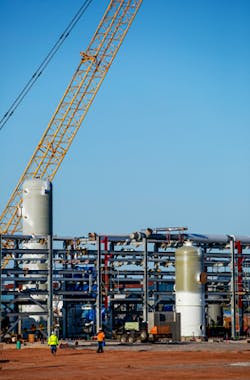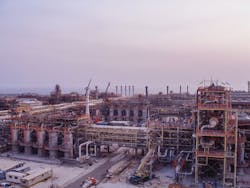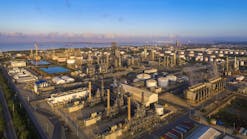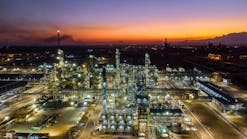Survey shows increase in refining construction
Oil and Gas Journal's semiannual Worldwide Construction Update shows an increase in refining construction activity compared with the previous edition of the update (OGJ, May 5, 2014, p. 37). Following are details from the latest survey, which is available online (see box).
OGJ subscribers can download free of charge the 2014 Worldwide Construction Update tables at www.ogjonline.com: Click on "OGJ Subscriber Surveys," then "Worldwide Construction." This link also includes previous editions of the update. Historical spreadsheets of data presented here are available for purchase from PennEnergy Research. Visit www.ogjonline.com, and click "Research" under the "OGJ Resources" tab. |
Refining
In May, Petroperu let a $2.7 billion lump-sum turnkey contract to Tecnicas Reunidas (TR) for the long-planned modernization and upgrade of its 60,000-b/d Talara refinery at Piura, 1,200 km north of Lima (OGJ Online, May, 29, 2014).
TR will provide execution of design and detailed engineering and procurement of all equipment and materials, and construction as well as start-up assistance of the crude processing units for the refinery's modernization, which is slated to be completed within 55 months, TR said.
The contract represents the largest refining turnkey project worldwide awarded to a single contractor, TR noted.
The project's objective is to equip the refinery to produce diesel and gasoline fuels conforming to new Peruvian environmental requirements of a maximum sulfur content of 50 ppm at competitive prices as well as increase the plant's ability to process heavy crudes to improve operational flexibility, TR said.
TR's scope of work will involve:
• The expansion and modification of existing process units, including the refinery's primary distillation unit, catalytic cracking complex, and vacuum distillation unit.
• The construction of processing units, which include a diesel hydrotreater, cracked naphtha and naphtha hydrotreaters, a vacuum distillation unit, flexicoker, naphtha catalytic reforming unit, amine unit, and cogeneration units.
• The expansion and upgrade of the utilities and off-sites installations.
Once completed, the project will enable the refinery to have minimal emissions, generate its own electricity, and maintain on-site operations for desalination of seawater and purification to avoid altering aquifers in the area, TR said.
Following completion of the $3.5 billion project, which is slated to run from 2014 to 2017, crude oil processing capacity at Talara will rise to 95,000 b/d from its current capacity of 60,000 b/d.
Meanwhile, in Belgium, ExxonMobil Corp. reported it will invest $1 billion to install a delayed coker at its 320,000-b/d Antwerp refinery (OGJ Online, July 2, 2014). The unit, which will convert heavy, higher-sulfur residual oils into transportation products such as marine gas oil and diesel fuel, comes as part of ExxonMobil's long-term strategy to help the refinery better compete in Europe's challenging industry environment, the company said.
Elsewhere, Petroleos Mexicanos has let a contract to South Korea's Samsung Engineering Co. Ltd. for the execution of an ultralow-sulfur diesel (ULSD) project at its Antonio M. Amor refinery in Salamanca, Guanajuato state (OGJ Online, Sept. 17, 2014). The $80 million contract, awarded on an open-book cost estimation basis, covers Phase 1 of the project, which includes detail engineering and procurement of long-lead items, Samsung Engineering said.
The project's design will include a 38,000-b/d hydrodesulfurization (HDS) unit as well as the revamp of the refinery's existing 53,000-b/d HDS unit, Samsung Engineering said. Initial engineering for Phase 1 of the project is slated for completion in September 2015, Samsung Engineering said. A second leg of the project, Phase 2, will include the rest of detail engineering, procurement, construction, and commissioning. Samsung Engineering, however, did not disclose further details regarding this stage of the project.
The Salamanca refinery upgrade is part of Pemex's $2.8 billion plan to increase ULSD production at five of Mexico's refineries. Upon unveiling details of the fuel quality project, Pemex confirmed the total value of Samsung Engineering's contract for the Salamanca project at about $359 million (OGJ Online, Sept. 15, 2014).
Petrochemicals
In US petrochemical project news, ExxonMobil let a contract to Jacobs Engineering Group Inc. to provide engineering, procurement, and construction services as part of a multibillion dollar ethane cracker project at its Baytown, Tex., complex and associated premium product installations in Mont Belvieu, Tex. (OGJ Online, July 1, 2013).
Jacobs will provide site-enabling works for the two sites, including site preparation of 350 acres for the ethane cracker in Baytown and 100 acres for the associated operations in Mont Belvieu, Jacobs said.
It will provide interconnectivity services for two sites by integrating a 1.5 million-tonne/year (tpy) ethane steam cracker in Baytown and two 650,000-tpy, high-performance polyethylene lines at the company's Mont Belvieu plastics plant. A value of the contract was not disclosed. ExxonMobil began construction on the US Gulf Coast ethylene expansion project in June (OGJ Online, June 19, 2014).
Elsewhere in Texas, Formosa Plastics Corp. has let a contract to Germany's ThyssenKrupp Industrial Solutions AG to provide process technology for a propane dehydrogenation (PDH) plant to be built as part of the third major expansion of its petrochemical complex in Point Comfort, Tex. (OGJ Online, June 3, 2013).
The contract includes licensing, basic engineering, detail engineering for the key equipment, delivery of STAR catalyst, and technical support during the entire project execution, ThyssenKrupp said. The PDH plant in Point Comfort will have a propylene production capacity of 545,000 tpy, ThyssenKrupp said. Neither a value of the contract nor a timeframe for the PDH project was disclosed.
In Louisiana, meanwhile, Yuhuang Chemical Inc., a newly formed subsidiary of Shandong Yuhuang Chemical Co. Ltd., plans to invest $1.85 billion in a world-scale methanol manufacturing complex on the Mississippi River in St. James Parish (OGJ Online, July 18, 2014).
The company has secured an option to purchase more than 1,100 acres for the three-phase project next to the Plains All American Pipeline (PAA) terminal, where Yuhuang Chemical intends to build two methanol plants with a combined capacity of 3 million tpy and a methanol derivatives plant to produce intermediate chemicals. Construction on the complex is slated to begin in 2016, with the first phase of the methanol project beginning operations by 2018.
China Huanqiu Contracting & Engineering Corp. will conduct engineering work, and Air Liquide Global E&C Solutions will provide licensed methanol technology.
LNG
In Australia, Bechtel completed the installation of the first LNG production train for the Santos Ltd.-led Gladstone LNG facility on Curtis Island, Queensland. The $20-billion project will have two trains-the second due for completion late this year (OGJ Online, May 13, 2014).
The first train is made up of 82 modules, built at Bechtel's yard in the Philippines. The company is the engineering, procurement, and construction contractor for all three CSG-LNG facilities under construction on Curtis Island (Santos' GLNG, BG's Queensland Curtis LNG, and Origin Energy's Australia Pacific LNG). First exports from the Queensland Curtis LNG project are scheduled for December. The project will produce 8.5 million tpy of LNG.
Meanwhile, in Canada, Woodfibre LNG Ltd., a subsidiary of energy resources development company Pacific Oil & Gas, let Linde Group a contract to provide engineering and procurement services for its 2.1-million tpy liquefaction plant in the District of Squamish near Vancouver, BC (OGJ Online, Sept. 12, 2014). The plant will use Linde's proprietary multistage mixed refrigerant Limum process technology. Woodfibre LNG will begin construction in 2015 to have the plant operational by 2017, pending regulatory approvals.
In the US, Louisiana LNG Energy LLC selected Bechtel to provide front-end engineering and design for a 2-million tpy liquefaction plant and LNG export terminal in Louisiana, south of New Orleans near Mile Marker 46 on the east bank of the Mississippi River. The project will be completed by late 2017 (OGJ Online, Oct. 8, 2014).
Natural gas
In the northeastern US, MarkWest Energy Partners LP will expand midstream infrastructure at its Keystone complex in Butler County, Pa., to handle growing rich-gas production from the Marcellus shale and Upper Devonian formations (OGJ Online, Aug. 26, 2014).
MarkWest will build Bluestone III and IV, each of which will handle 200 MMcfd and begin operations in fourth-quarter 2015 and second-quarter 2016, respectively.
Further south and west, in Oklahoma, Oneok Partners LP, Tulsa, will spend $365-470 million by yearend 2016 to build a 200-MMcfd gas processing plant and related infrastructure in Grady and Stephens counties (OGJ Online, July 24, 2014).
The Knox plant will increase Oneok's Oklahoma gas processing capacity to 900 MMcfd. It and the related infrastructure, including expansions and upgrades to the company's existing gas gathering and compression, are to be completed during fourth-quarter 2016.
The estimated costs include $175-240 million to build the plant and $190-230 million to build related systems, including gas gathering pipelines and compression.
Meanwhile, in Texas, Enterprise Products Partners LP (EPP) says it will build the ninth NGL fractionator for its complex in Mont Belvieu. The fractionator will have a nameplate capacity of 85,000 b/d and is expected to begin operations as early as January 2016.
The addition gives EPP a gross nameplate NGL fractionation capacity of 755,000 b/d at Mont Belvieu and total gross NGL fractionation capacity of 1.2 million b/d. Mont Belvieu also will be capable of producing 265,000 b/d of propane.
Other gas, sulfur
In Mozambique, Sasol Ltd. reported it has signed a joint prefeasibility study to assess the viability and benefits of a "large-scale" gas-to-liquids plant. The plant's design capacity was not disclosed (OGJ Online, July 3, 2014).
The study, which is being conducted in conjunction with Mozambique's state ENH and Italy's Eni SPA, will be based on gas from the Rovuma basin in the northern part of the country (OGJ Online, May 27, 2014).
Eni is operator of the Area 4 deepwater block in the Rovuma basin, which is estimated to hold as much as 85 tcf of gas in place.
Foster Wheeler is working on a 250-tonne/day sulfur unit for Petroleos de Venezuela (PDVSA). The project is in Carabobo and will be completed in 2016.
Pipelines
PAA also plans to construct a 440-mile, 20-in. crude oil pipeline that will carry as much as 200,000 b/d of sweet crude from PAA's Cushing, Okla., terminal to Valero's Memphis Refinery (OGJ Online, Aug. 22, 2014). The project is expected to cost $900 million and be completed in late 2016.
PAA says the pipeline, to be called Diamond, also will provide access to Valero Energy Partner's Collierville line and is underpinned by a long-term shipping agreement with Valero and a related contract for storage and terminalling services at PAA's Cushing terminal. In addition to Diamond, PAA is currently building the 310-mile, 20-in. Cactus crude oil pipeline from McCamey, Tex., to Gardendale, Tex. The company expects it to cost $350-375 million and enter service first-quarter 2015 (OGJ Online, Apr. 16, 2013).
Meanwhile, in Oklahoma, Tall Oak Midstream LLC, Edmond, Okla., will construct 250 miles of low-pressure gas gathering pipeline in Payne County in the central northern Oklahoma Woodford play (OGJ Online, June 25, 2014).
The pipeline will serve multiple producers in the play's "liquids-rich, stacked pay zones," including the Mississippi Lime, Woodford shale, and Cleveland formations. It also will provide direct access to downstream markets including Southern Star Central Gas Pipeline and Enable Gas Transmission for residue gas.
Meanwhile, EPP also will build a 75-mile, 12-in. OD NGL pipeline to transport liquids from the South Eddy plant to the company's Hobbs, NM, NGL fractionation and storage in Gaines County, Tex. In addition, EPP plans to build pipelines to deliver residue gas from the new plant to "multiple third-party" pipelines. The pipelines will come online in first-quarter 2016, EPP said. The company will build 80 miles of gas gathering pipelines to complement its existing 1,500 miles of gas pipelines in the basin.
Leena Koottungal | Survey Editor / News Writer
Leena Koottungal is the Survey Editor/News Writer for Oil & Gas Journal. She joined PennWell in April 2006.



